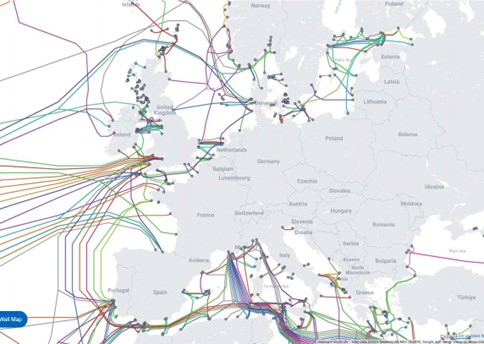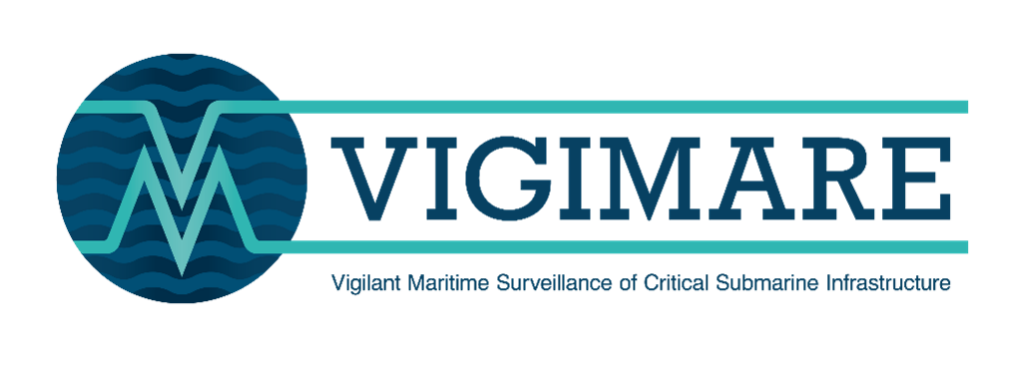The European submarine network is a vital Critical Infrastructure (CI) for EU member states. This network is crucial for European society, and any failure or damage could have significant repercussions. The rapidly evolving threat landscape, highlighted by incidents such as the sabotage of the Nord Stream 1 and 2 gas infrastructure in 2022 and the damages to cables and pipelines in the Baltic sea during the recent years, presents substantial challenges for organizations overseeing this network. These entities must now address intentional threats while also managing issues caused by accidental and natural factors, as well as climate change, which can exacerbate the effects of deliberate actions.
 Submarine Cable Map (TeleGeography https://www.submarinecablemap.com/)
Submarine Cable Map (TeleGeography https://www.submarinecablemap.com/)
Resilience in Critical Infrastructure
To effectively address these challenges, it is essential for CI entities to implement resilience-enhancing measures. Resilience refers to an entity’s ability to prevent, protect against, respond to, resist, mitigate, absorb, accommodate, and recover from events that could significantly disrupt or actually disrupt the provision of essential services. This concept necessitates a systems-based approach and requires an accurate, real-time, and comprehensive understanding of the most significant risks faced by entities operating CI (Axis Newsroom, 2025, Resilience of critical entities).
The European Union’s Critical Entities Resilience Directive (CER Directive) emphasizes the importance of resilience for entities involved in providing essential services. This directive requires entities to evaluate risks, adopt resilience measures, and ensure compliance with regulations to protect vital economic and societal functions (EUR-Lex, 2022, Directive (EU) 2022/2557) .
Current Governance and Recommendations
According to a European Parliament (EP) report from 2022 (European Parliament, 2022, The impact of the COVID-19 pandemic on EU industries), submarine cables have previously often been overlooked and have received limited attention from policymakers due to their hidden nature underwater. However, the current geopolitical situation, has brought growing public and policy attention to this vulnerability. Despite this, the report indicates that European governance of maritime cable and pipeline protection and resilience is lagging and requires improvement.
The EP report provides several recommendations for enhancing cable resilience, such as increasing Awareness, improving Information Sharing, and strengthening the Surveillance of them.
The Joint EU Action Plan on Cable Security
On February 21, 2025, the European Commission and the High Representative of the Union for Foreign Affairs and Security Policy unveiled a comprehensive EU Action Plan on Cable Security (European Commission,2022, Joint communication to strengthen the security and resilience of submarine cables). This plan further addresses the critical need to protect submarine cables, stressing their importance for the EU’s strategic interests. The Action Plan represents a coordinated European response to the growing threats facing this critical underwater infrastructure.
The Action Plan was developed following a series of suspicious incidents targeting underwater infrastructure in European waters, particularly after Russia’s invasion of Ukraine heightened concerns about hybrid warfare tactics. It builds upon the EU’s Critical Infrastructure Protection framework while addressing specific challenges posed by the complex ownership structures, jurisdictional ambiguities, and technical vulnerabilities of cable systems.
The Action Plan aims to balance security requirements with the need to maintain an open, competitive market for telecommunications infrastructure while ensuring that Europe can protect its strategic autonomy in an increasingly contested global environment.
The VIGIMARE Project
 Figure: VIGIMARE project logo
Figure: VIGIMARE project logo
Laurea University of Applied Sciences is coordinating the EU funded VIGIMARE project, which represents a significant step forward in the protection and resilience of Europe’s critical submarine infrastructure network. By developing innovative solutions and fostering cooperation between CIOs, member states, and EU authorities, the project aims to mitigate risks and enhance security. The project’s innovative solutions, including the Virtual Control Room, AI services, and comprehensive risk assessments, contribute significantly to enhancing the security and resilience of Europe’s submarine network.
The EU Action Plan on Cable Security outlines a comprehensive strategy to enhance the resilience and security of submarine cables, focusing on prevention, detection, response, repair, and deterrence. The VIGIMARE project, with its focus on strengthening the resilience of critical submarine infrastructure, aligns well with the priorities and actions set out in this plan. Here’s how VIGIMARE addresses the key components of the EU Action Plan:
1. Prevention: Increasing Resilience and Preparedness
EU Action Plan:
- Implementing the CER and NIS2 Directives to enhance resilience and security.
- Conducting risk assessments and adopting resilience strategies.
- Developing a Cable Security Toolbox with mitigating measures.
VIGIMARE Response:
- Implementation of Directives: VIGIMARE supports the implementation of the CER and NIS2 directives by providing tools and methods to help CIOs meet these requirements. This includes mapping vulnerabilities and risks and defining strategies for enhancing resilience.
- Risk Assessments: The project conducts comprehensive risk assessments, including societal impact, and develops tools for assessing vulnerabilities and capabilities. These assessments align with the EU’s focus on identifying and mitigating risks.
- Mitigating Measures: The VIGIMARE solution, the project’s development of the Virtual Control Room (VCR) for situational awareness powered by AI services, enables early warnings and anomaly detection, that directly contributes to the Cable Security Toolbox, enhancing the ability to prevent and mitigate threats.
2. Detection: Increasing Monitoring and Detection Capacity
EU Action Plan:
- Developing an Integrated Surveillance Mechanism for Submarine Cables.
- Enhancing situational awareness through systems like EMSA, MARSUR, and CISE.
- Utilizing advanced technologies for real-time monitoring and detection.
VIGIMARE Response:
- Integrated Surveillance: VIGIMARE’s VCR integrates data from various sources, providing a comprehensive situational awareness picture. This aligns with the EU’s goal of creating an integrated surveillance mechanism.
- Advanced Technologies: The project employs AI services for early detection of threats, including physical, cyber, and hybrid attacks. These technologies enhance real-time monitoring and detection capabilities.
- Situational Awareness: VIGIMARE’s focus on building near real-time situational awareness for both onshore and offshore areas support the EU’s objective of improving detection and monitoring of threats.
3. Response and Recovery: Coordinated Crisis Response
EU Action Plan:
- Enhancing EU’s crisis response frameworks.
- Developing a Cable Vessels Reserve Fleet for rapid repair and deployment.
- Ensuring the availability of repair equipment and spare parts.
VIGIMARE Response:
- Crisis Response: VIGIMARE enhances the ability of CIOs to respond to incidents through improved situational awareness and coordination. The VCR facilitates real-time communication and coordination during crises.
- Repair and Recovery: While VIGIMARE does not directly address the creation of a Cable Vessels Reserve Fleet, its focus on resilience and preparedness ensures that CIOs are better equipped to handle repairs and recover from incidents.
- Support for Directives: The project’s tools and methods support the implementation of the CER and NIS2 directives, ensuring that CIOs can meet their obligations and enhance their crisis response capabilities.
4. Deterrence: Holding Malicious Actors Accountable
EU Action Plan:
- Enhancing the EU’s deterrence posture through attribution and sanctions.
- Addressing hybrid campaigns and the shadow fleet.
VIGIMARE Response:
- Deterrence Measures: VIGIMARE’s focus on resilience and early detection contributes to the EU’s deterrence posture by making it more difficult for malicious actors to succeed. The project’s tools for risk assessment and situational awareness help identify and attribute threats.
- Hybrid Threats: By addressing both physical and cyber threats, VIGIMARE supports the EU’s efforts to counter hybrid campaigns. The project’s comprehensive approach to security enhances the overall deterrence against such threats.
Conclusion
The VIGIMARE project is crucial for enhancing the resilience and security of Europe’s submarine infrastructure. It aligns with the EU Action Plan on Cable Security, addressing vulnerabilities and ensuring compliance with directives. The project introduces innovative technologies like the Virtual Control Room powered by AI for real-time monitoring and detection. By addressing both physical and cyber threats and validating solutions in various sea areas, VIGIMARE significantly strengthens Europe’s ability to protect its critical underwater infrastructure.
For more information about the VIGIMARE project, visit the project website: www.vigimare.eu.
References
The feature image is not licensed under CC BY-SA. It has been used in accordance with the terms of the Adobe Stock Education License and may not be reused or redistributed without separate permission.